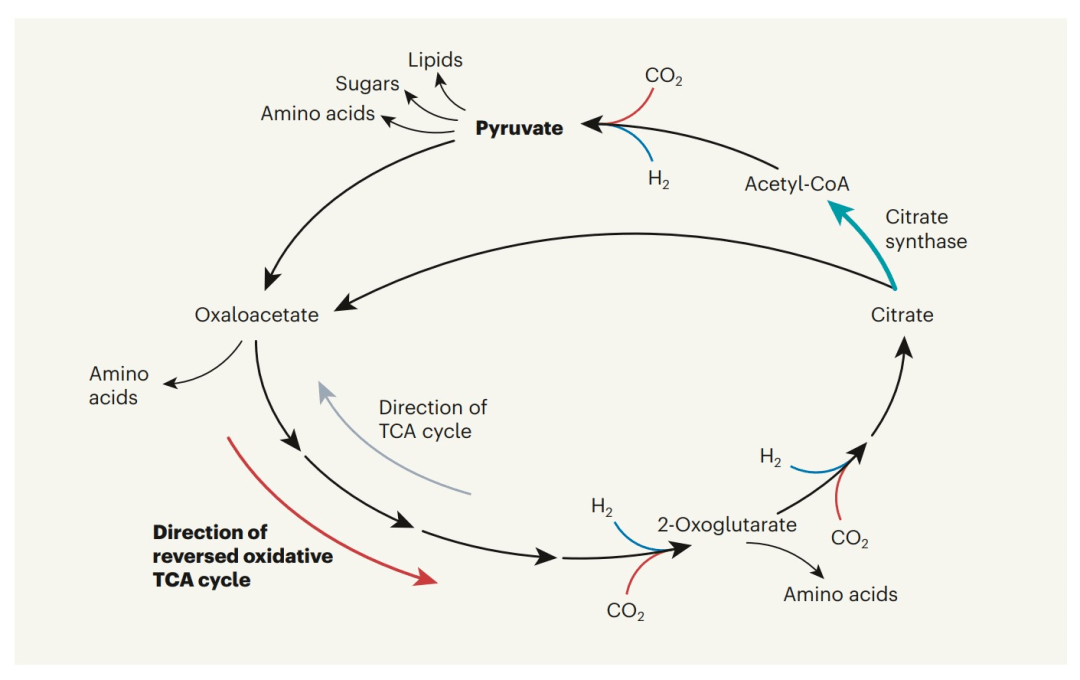创新背景
二氧化碳现在成为了气候问题的重要导火索,但在生态系统中,二氧化碳是万物生长的碳源,生命形式的奇妙机制或许能为温室气体排放问题提供新的方法。
创新过程
以前的研究认为,生命形式能量代谢的途径都是三羧酸循环,又称柠檬酸循环或TCA循环,是一个由一系列酶促反应构成的循环反应系统。在系统反应过程中,先由乙酰辅酶和草酰乙酸缩合生成含有3个羧基的柠檬酸,经过4次脱氢、1次底物水平磷酸化后,最终生成二氧化碳分子,并且重新生成草酰乙酸。TCA循环是三大营养素的最终代谢通路,会将食物中的糖、脂肪和蛋白质最终转化为能量和二氧化碳。

德国明斯特大学的Ivan A. Berg研究团队和慕尼黑工业大学的Wolfgang Eisenreich团队合作,发现在某些细菌中存在逆向运行TCA循环,使得细菌在二氧化碳充足的环境中可以茁壮成长。相关研究成果论文《高CO2 水平推动 TCA 循环向自身萎缩方向发展》于2022年发表在《自然》上。
研究以Hippea maritima细菌为研究对象,通过使用13C碳同位素标记法追踪细菌吃掉的二氧化碳,记录中间分子13C的积累,表征出Hippea maritima细菌的逆向TCA循环过程。

Hippea maritima细菌在二氧化碳充足的情况下会将其作为碳源,细菌中水平极高的柠檬酸合酶会推动反应生成更多的乙酰辅酶A。乙酰辅酶A通过二氧化碳的作用形成丙酮酸,结束在正向TCA循环中的重要地位,然后丙酮酸进一步转变为糖、脂和氨基酸。细菌环境中高浓度的二氧化碳不断推动乙酰辅酶A转化。

研究发现细菌在特定生长条件下逆向运行TCA循环可能是因为柠檬酸合酶。柠檬酸合酶在大多数生命体中都不可逆。在逆向的氧化TCA循环中,柠檬酸合酶取代了还原性TCA循环中的ATP柠檬酸裂解酶,水平极高,导致循环中每转一圈小号的ATP当量都在减少。
德国杜塞尔多夫大学的研究人员认为,发生逆向TCA循环的细菌不止Hippea maritima,且氢气可能也参与了循环,二氧化碳和氢气结合形成糖、脂质和氨基酸。
创新价值
研究为微生物生态学提供了新见解,同时也为二氧化碳问题提供了新的可能性方式,利用细菌或许能缓解二氧化碳排放,通过储存循环使其成为新型有效物质。
The reverse TCA cycle converts carbon dioxide into amino acids, sugars, and lipids
Previous studies have suggested that the pathways of energy metabolism in life forms are the citric acid cycle, also known as the citric acid cycle or TCA cycle, which is a circulatory reaction system composed of a series of enzymatic reactions. In the process of systematic reaction, citric acid containing 3 carboxyl groups was first formed by condensation of acetyl-Coenzyme and oxaloacetic acid, and after 4 times of dehydrogenation and 1 time of substrate level phosphorylation, carbon dioxide molecules were finally generated, and oxaloacetic acid was regenerated. The TCA cycle is the final metabolic pathway of the three major nutrients, which ultimately converts the sugars, fats, and proteins in food into energy and carbon dioxide.
Working with the team of Ivan A. Berg at the University of Münster in Germany and the Wolfgang Eisenreich team at the Technical University of Munich, they found that there is a reverse-running TCA cycle in some bacteria, allowing bacteria to thrive in an environment with abundant carbon dioxide. The related research paper "High CO2 Levels Promote the Development of the TCA Cycle towards Its Own Shrinkage" was published in Nature in 2022.
Using Hippea maritima bacteria as the research object, the 13C carbon isotope labeling method was used to track the carbon dioxide eaten by the bacteria, and the accumulation of intermediate molecule 13C was recorded, characterizing the reverse TCA cycle process of Hippea maritima bacteria.
Hippea maritima bacteria use it as a carbon source when carbon dioxide is abundant, and extremely high levels of citric acid synthase in bacteria push the reaction to produce more acetyl-CoA. Acetyl-CoA forms pyruvate by the action of carbon dioxide, ending its important position in the positive TCA cycle, which is then further transformed into sugars, lipids, and amino acids. The high concentration of carbon dioxide in the bacterial environment continuously drives acetyl-CoA transformation.
Studies have found that bacteria running the TCA cycle in reverse under specific growth conditions may be due to citrate synthase. Citric acid synthase is irreversible in most living organisms. In the reverse oxidative TCA cycle, the citric acid synthase replaces the ATP citrate lyase in the reducing TCA cycle, and the levels are extremely high, resulting in a decrease in the ATP equivalent of each revolution in the cycle.
Researchers at the University of Düsseldorf in Germany believe that the bacteria that reverse the TCA cycle are not only Hippea maritima, but also hydrogen may also be involved in the cycle, and carbon dioxide and hydrogen combine to form sugars, lipids and amino acids.
智能推荐
细胞学创新 | 使用LLPS创新发现分子分离受到细胞大小调节影响
2022-10-31对分子分离影响因素的新发现有助于生物技术和人造细胞工程发展,可以模仿生物细胞的功能并执行各种任务,推动细胞对病毒做出反应,可推动开发人造皮肤以测试化妆品,或制造食品防腐剂,帮助多个行业避免其产品中人造细胞特性的意外变化。
涉及学科涉及领域研究方向通过追踪鞘脂新技术发现母乳喂养对婴儿肠道微生物群的影响
2022-08-19研究团队开发了一种新技术,能够跟踪饮食中的鞘脂通过小鼠肠道时的情况,首次发现了拟杆菌和双歧杆菌在母乳中的重要性。
涉及学科涉及领域研究方向PRC2蛋白质调节决定胚胎发育的最初细胞
2022-08-08通过模仿怀孕的第一周观察胚胎细胞,使用胚胎模型探究PRC2蛋白质
涉及学科涉及领域研究方向